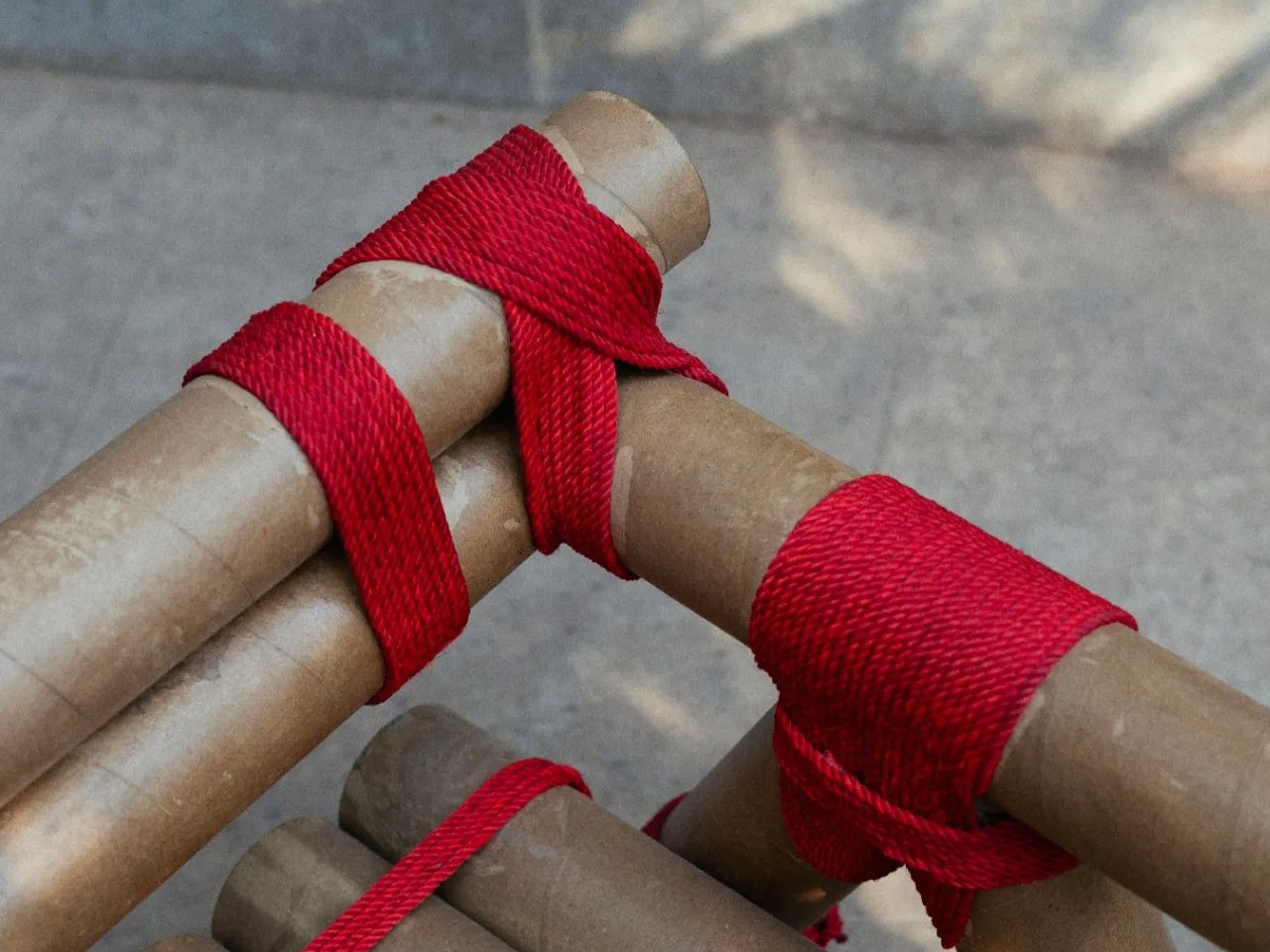The Paper Tube Chair poses a profound question about design democracy. Designed the Dhammada Collective, the chair drew inspiration from Pierre Jeanneret’s celebrated teak library chairs, yet luxury teak was replaced in favor of discarded cardboard tubes. Dhammada Collective was founded by Nipun Prabhakar in Bhopal, and the interdisciplinary studio challenges the commodification of furniture through unique and radical material choices. The chairs beautifully capture the concept of “joyful frugality”, which involves making good design principles available to communities beyond metropolitan centers.
Construction begins with salvage operations at a local offset print shop, where cardboard cores accumulate twice monthly. These thick tubes face landfill disposal due to glue layers that prevent recycling, creating an abundant waste stream. The design intercepts fifteen tubes, cutting them like bamboo segments for structural assembly. Bright vermilion rope, leftover from weaving workshops, binds the components through continuous figure-eight lashing patterns. This rope system performs structural miracles, tightening under load while maintaining component replaceability.
Designer: Dhammada Collective
The assembly process unveils a deep and thorough understanding of material behavior. Early prototypes collapsed spectacularly, teaching the team to insert smaller tubes at critical joints and trust tension over adhesive bonds. The rope flexes with movement, accommodating user weight while preserving structural integrity. Each tube receives a thin varnish coat that seals fibers while preserving scratches and printer codes. This style of finishing cherishes material history, letting it shine, rather than concealing origins.
The lashing technique allows for easy disassembly and repair, making the chair genuinely sustainable throughout its lifecycle. Component replacement requires only basic materials and rope-working skills, democratizing maintenance processes. The structure adapts to various body types through slight flex in the rope connections. Weight distribution across multiple contact points creates surprising comfort despite minimal padding.
The studio decided to adopt an open-source philosophy, transforming the simple yet powerful furniture piece into a design template. Prabhakar encourages adaptation and experimentation, sharing construction experiences and documented failures with interested makers. The project requires only print-shop tubes and rope, making replication accessible across different economic contexts. The chair perfectly aligns with the collective’s mission to serve Tier 2 cities and rural communities overlooked by mainstream design practice. The chair becomes a catalyst for local making culture.
Cultural resonance emerges through the design’s relationship with Indian modernist heritage. The bright vermilion rope creates visual warmth that softens industrial materials, referencing traditional craft techniques. This marriage of modernist geometry with vernacular making processes creates furniture that feels both contemporary and rooted.
FAQs
1. Is cardboard furniture durable enough for everyday use?
Cardboard furniture, when designed with thought and intention, can be surprisingly strong and sturdy for daily living. The Paper Tube Chair by Dhammada Collective shows this resilience through its structural use of thick, industrial cardboard tubes and a rope lashing system that tightens under load. Early prototypes revealed weaknesses, but the final design incorporates smaller tubes at critical joints and relies on tension rather than adhesives, creating a chair that flexes with movement and distributes weight efficiently. While it may not match the longevity of hardwood furniture, its construction is more than adequate for regular use, especially when users follow basic care and maintenance practices.
2. How sustainable is the paper tube chair compared to traditional furniture?
The Paper Tube Chair is quite sustainable when compared to conventional furniture. Instead of relying on new, resource-intensive materials like teak, the chair is built from discarded cardboard tubes—an abundant waste product from local print shops that would otherwise end up in landfills. The use of leftover rope for lashing and a minimal varnish finish further reduces environmental impact. Its open-source, repairable design extends the chair’s lifecycle and democratizes access to good design, making it easy to maintain and adapt.
3. How comfortable is a chair made from cardboard tubes and rope?
A chair made from cardboard tubes and rope can be pretty comfortable if created with care and understanding of material behavior. The Paper Tube Chair uses thick cardboard tubes for structure and bright vermilion rope for flexible lashing, allowing the seat to subtly adapt to different body types. The rope connections flex under weight, distributing pressure across multiple contact points and creating a gentle give that enhances comfort, even with minimal padding.
The post Open-Source, Upcycled & Beautifully Functional: The Ultimate Eco-Friendly Chair for Modern Living first appeared on Yanko Design.

